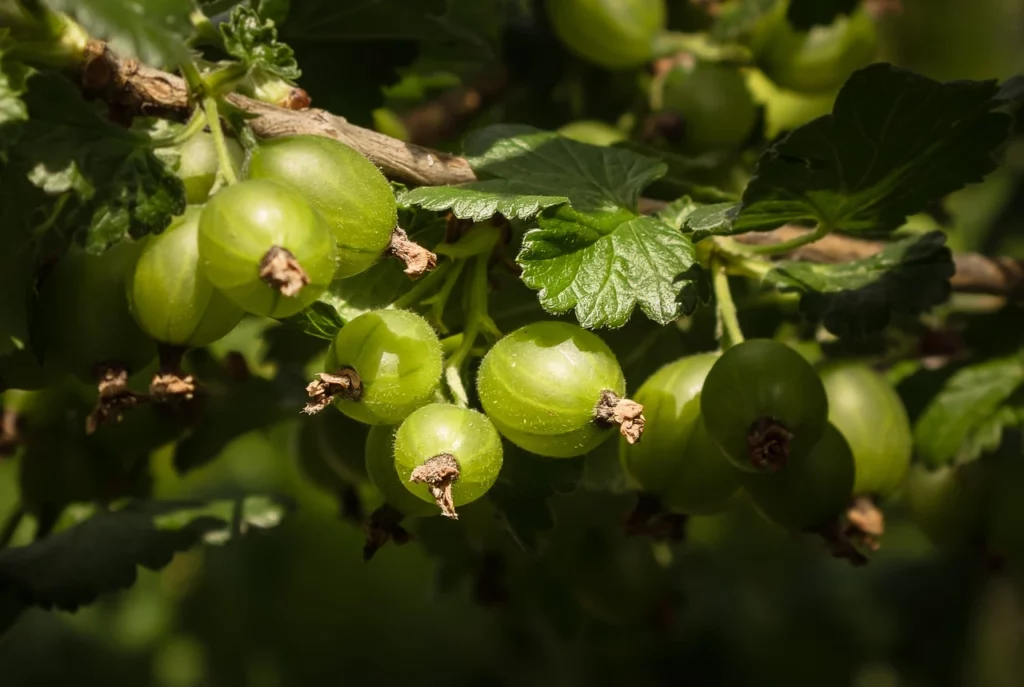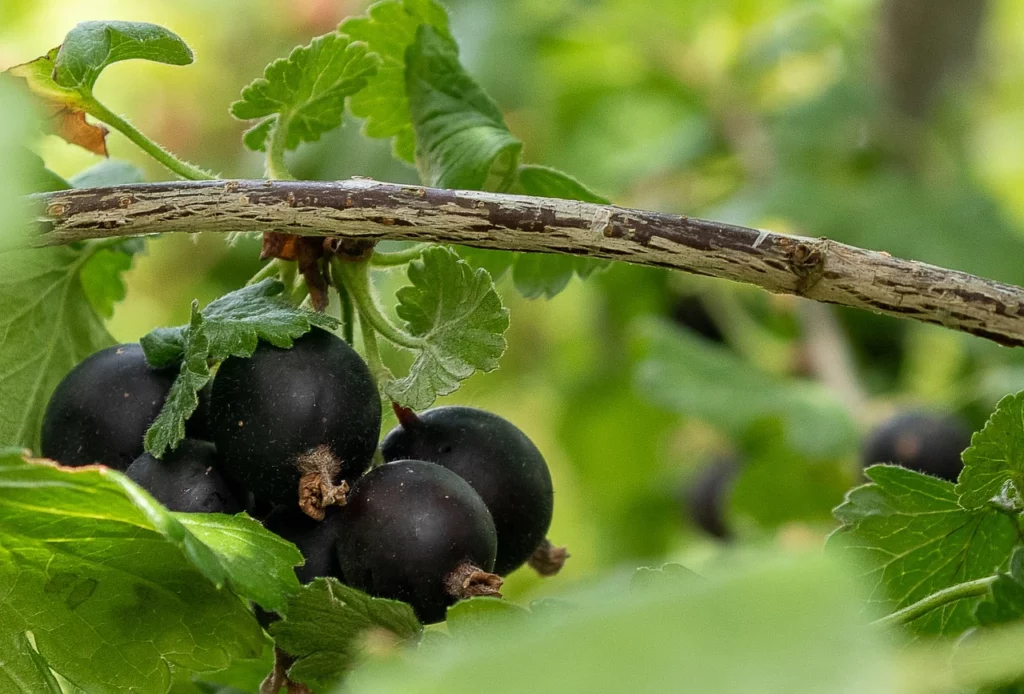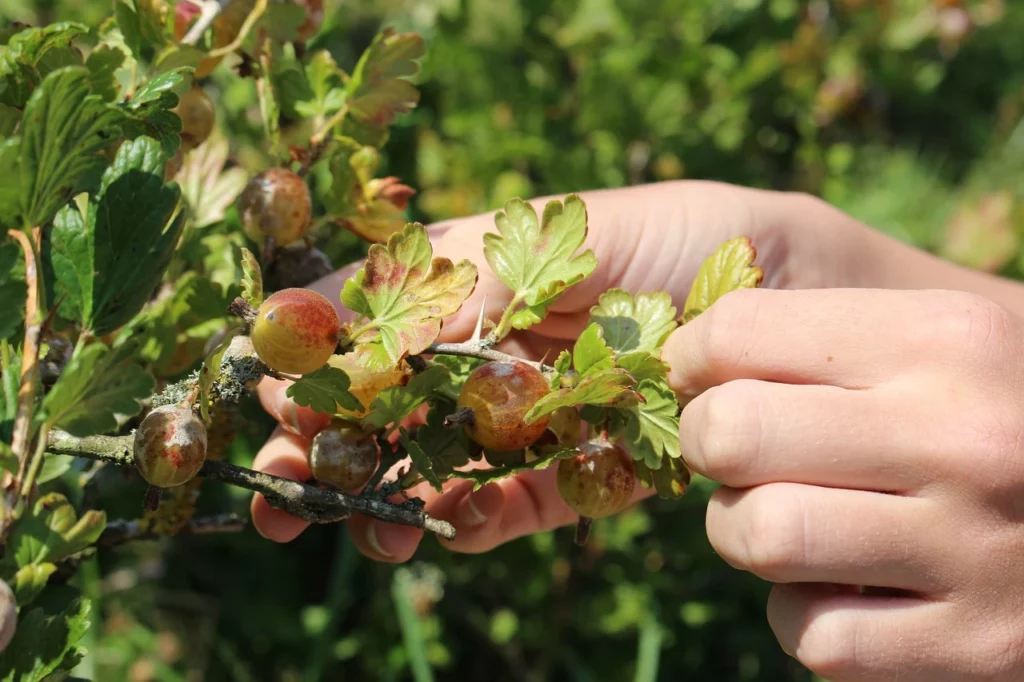Gooseberries are native to Europe and well adapted to temperate climates. The hardy, robust shrub is easy to care for and the perfect addition to your garden berry hedge. Gooseberries are not only delicious, but also very healthy. The cultivation is worthwhile in any case! What you need to know about cultivation and what to consider when caring for and harvesting gooseberries, you will learn in this article!
- At a glance
- Light: semi-shade
- Water: moist
- Nutrient requirements: high
- Soil: medium
- Planting distance: 0.8 to 2 m depending on growth habit
- Planting depth: at ground level
- Good neighbors: blueberry, currant, garlic, lemon balm, marigold, chives, gooseberry, vine tomato
Contents
General information about gooseberries
Gooseberries (Ribes uva-crispa) are a species of the genus Ribes, as are the closely related currants. Together they form the gooseberry family (Grossulariaceae). The bushy, deciduous shrub can reach a height of up to 3 m, but rarely grows over 1.5 m in most gardens. Its branches are covered with the characteristic spines from which the berries got their name. Hanging inflorescences develop from the leaf axils between April and May. One to three flowers grow from a leaf axil. These flowers are hermaphroditic, allowing one flower to self-fertilize. After fertilization, small, hairy berries develop, which grow rather elongated or spherical, depending on the variety, and turn green, yellow or dark red.
Depending on the variety and color, the fruits differ in taste. Red gooseberries taste sweet and are hardly hairy, while green and yellow have a more sour taste. Gooseberries are very healthy and contain many vitamins, minerals and secondary plant compounds. The diversity of varieties is now vast. New breeding has already produced varieties without thorns, which greatly facilitates the harvest. In addition, there are now some varieties that are resistant to common fungal diseases, such as powdery mildew. While this disease is not life-threatening to a gooseberry bush, it unfortunately renders the berries inedible. Leaves and fruit become covered with an unappetizing coating of mold. For you to get a good yield, a resistant variety can be beneficial.
Here is a list of robust varieties:
- ‘Captivator’: this variety produces sweet and sour red fruits. Besides resistance to powdery mildew, this variety has another advantage: its branches are hardly covered with thorns. Moreover, the thorns become fewer from year to year. This guarantees an effortless harvest!
- ‘Invicta’: This variety is high-yielding and produces many light green, sweet fruits. It is resistant not only to powdery mildew, but also to leaf drop diseases.
- ‘Remarka’: Its dark red fruits are large, sweet and very aromatic. It is particularly resistant and strong defense against powdery mildew. If there is a lot of fungal pressure in your garden, this variety is a good choice!
- ‘Redeva’: This high-yielding variety is also hardly susceptible to powdery mildew as well as leaf drop diseases. In addition, its fruits have high burst resistance and are not very susceptible to sunburn. You can also plant this variety in a sunny location without any problems. The fruits are purple in color and sweet to slightly tart in flavor.
- Planting gooseberries: Soil, location & mixed cultivation
Native wild forms of gooseberry grow in sparse, moist to moderately moist woods or forest edges. For this reason, you should choose a location with nutrient-rich, loamy soil. Sandy soils that tend to dry out should be amended with compost. This improves the water retention capacity and also increases the pH value. Gooseberries prefer a site rich in bases, and the pH value should be between 6 and 7. Otherwise, the shrub is not particularly demanding on the soil and climate. Choose a semi-shaded place, because from too much sun the berries like to get a sunburn. The optimal place is in the shade of larger fruit trees or other shrubs. In addition, a full sun location will make the shrub more susceptible to powdery mildew (especially when combined with fertilization that is too high in nitrogen). Although low temperatures are not a problem for the hardy shrub, you should not plant it in locations that are prone to late frosts. Otherwise, due to the early flowering, the frost can cause damage to the flowers, which may cost you the harvest.

To further protect the shrub from diseases, you should plant it in a mixed culture:
Good neighbors: yarrow, garlic, lily of the valley, marigold, blueberry, currant, lemon balm, marigold, chives, gooseberry, vine tomato.
Bad neighbors: sage
You can also integrate gooseberries into a forest garden. This works with permaculture and mixed culture principles, creating a stable system that is less susceptible to disease or pests. You can read about which fruit trees you can plant for this and how to underplant them in the article Planting Fruit Trees.
When can I plant gooseberries?
Gooseberries are best planted in late fall (October – November) or early spring (by April at the latest). However, planting in the fall has the advantage that the bush can grow properly over the winter. This is because gooseberries are shallow-rooted and therefore dry out relatively quickly, which makes it difficult for them to grow. The winter moisture allows the bush to root well in the soil and thus reliably sprout again in the spring. So when planting to dry periods in the summer, you should always make sure that the root ball is always moist.
How do I plant gooseberries?
Gooseberry plants are grown bare-root (i.e. ungrafted) or as a grafted half or high trunk. Both forms are suitable for planting in the garden, it just depends on your preferences, wishes and the available space. A shrub needs 1.2 to 2 m of space, depending on the variety. Whereas a high trunk is more space efficient and requires about 0.8 to 1 m of planting distance, depending on the variety planted. If you want to plant a dense hedge, you can choose a smaller distance in each case.
Once you have chosen a variety that suits you, you need to decide on the type of planting. Do you want to plant a hedge or individual shrubs? Should the growth form be tall or shrubby?
Here once listed the advantages and disadvantages of both forms of growth:
High-stemmed shrubs are easier to harvest. Especially for varieties with many thorns grafted plants are advantageous, because it facilitates care and harvesting. In addition, this growth form is more space-saving and can also be grown on the balcony. On the other hand, the young plants are more expensive to buy (this is due to the previous grafting of the bushes) and you must also attach a support stake for the bush. This support stake must be regularly renewed and adjusted to the size due to the strong growth of the gooseberry. Another disadvantage of the high stem is that the yield decreases. Due to the long trunk, there are fewer bearing branches and thus less fruit.
A shrub, on the other hand, is more cluttered in its growth, making harvesting more difficult. Additionally, you have to bend down to get to the berries. One advantage of planting a shrub is that the young plants are less expensive to purchase. In addition, there is no need to install a support stake and constantly renew it. In addition, the yield of a shrub is much higher than that of a high stem.
Instructions for planting in the garden
- Before planting: loosen the soil deeply with a digging fork. Sandy soil should be prepared with compost.
- Dig planting hole: Dig a planting hole twice the size of the root ball. Add a little compost or slow-release fertilizer to the planting hole.
- Root pruning: For bare-root plants, shorten all roots by a few inches. This improves the growing process by stimulating root growth.
- Planting: Set the shrub in the ground. The plant should be planted at ground level. Pour the soil back into the hole. To minimize voids around the roots in the soil, you can also gently shake the trunk. Press the soil down well and water your new charge properly.
For a high trunk, attach a support stake directly after planting. To do this, place a wooden trunk right next to the root ball and tie the trunk with wide ribbons or coconut rope. Be careful not to damage any roots!
Apply a layer of mulch. It serves as a natural protection against weeds and reduces water evaporation.
Pruning: Cut all shoots by about one third. Cut the branches just above an outward growing bud.

Our tip: Although gooseberries are self-pollinators, you can increase the yield by planting plants of the Ribes genus next to each other. This includes not only other gooseberry varieties, but also currants or the Josta berry. The Josta berry is a cross between the currant and the gooseberry. The flowers of your gooseberry bush can be fertilized by the pollen of all these plants. By planting more plants, you increase the probability of fertilization enormously and thus also your yield. Besides, you will have a greater variety of different plants in your garden, which insects and other garden inhabitants will enjoy.
Care of gooseberries
- Fertilize once a year: This is best done before budbreak in spring (until April). A fertilizer that is low in nitrogen but high in potash is suitable for this purpose. If the nitrogen fertilization is too high, there is a higher risk of mildew infestation. If necessary, you can follow up with a second fertilization after flowering in May.
- Apply a layer of mulch and renew it regularly. This keeps the soil moist longer, which is an advantage for the shallow-rooted berries. It also suppresses weeds. Make sure the mulch layer is loosely distributed around the trunk, otherwise rot can develop.
- Regularly remove weeds that grow around the gooseberry. When doing this, you should not use a rake, so as not to injure the roots of the bush. It is better to remove them carefully by hand.
- Gooseberries are sensitive to drought. Therefore, especially during dry periods, you need to water regularly so that the bush can develop many berries.
- After flowering from April – May, you can reduce the number of flowers in case of strong growth. Thinning helps the formation of the remaining fruits and increases their quality. The rule is: the thinner the branches, the better the light supply and thus the better the harvest.
- Regularly inspect your shrubs for pests and diseases. I will list the most common ones in the next point. It is important to know that whitish spots on the fruits or brown, dried fruits do not have to have a biotic cause. It can also be sunburn caused by too much exposure to the sun.
Common pests & diseases of gooseberries
Check your bushes regularly for infestations of powdery mildew. Gooseberries are particularly susceptible to this fungus. The best preventive measure is to plant resistant varieties. You can recognize an infestation by the characteristic white coating on the top of the leaves and by brown discolored shoot tips. The only remedy is to remove the affected shoots. Do not dispose of them in the compost, but in the residual waste, in order to contain further spread of the fungus in your garden.
If the leaves of the shrubs curl, this often indicates an infestation of (red) spider mites or scale insects. You can use neem oil, tea tree oil or beneficial insects against these uninvited guests. Against spider mites, predatory mites are the beneficial insects of choice, in case of a light infestation you can also use lacewings. The natural enemies of scale insects are ichneumon flies, ladybugs and earwigs. Never use neem oil if you have also applied beneficial insects! Neem oil has a nonspecific effect and also kills the little helpers.
Gooseberry pruning
Gooseberries bear their fruit on the one-year-old side shoots of older branches. To encourage their formation and growth, regular pruning is essential. After planting and pruning, you should cut back your gooseberry bushes annually in the spring (February – March). At this time, the heaviest frost is over and the weather becomes sunnier and drier. For pruning, choose a day in a rain-free period of about three days. Otherwise, pathogens can more easily penetrate the cut wounds due to the water. In this regard, the pruning of a shrub is no different from that of a high stem.
Prune annually to rejuvenate the shrub:
- Shorten the most vigorous five to six ground shoots by about one-third. Cut off the shoots above an outward-pointing bud or an outward-growing side shoot to give the shrub a bushy shape. Cut off the remaining ground shoots close to the ground.
- Remove the three to four year old, worn leading and side shoots. You can also do this directly after harvesting. You can either remove these shoots completely or cut them off above a deeper side shoot. One-year-old side shoots must remain in any case, since they carry the crop for the next year.
- Side shoots that are too dense or growing inwards and dead wood should also be removed from the shrub. In this way you will achieve better lighting and ventilation. Better aeration reduces the risk of your shrub being attacked by powdery mildew and other fungal diseases. Also, thinning makes it easier to harvest prickly varieties.
- When pruning, make sure the shoots are evenly spaced so there is no competition among individual shoots for light.
- In subsequent years, always replace two old ground shoots with new ones. To do this, cut off the old shoots close to the ground. As a replacement, look for two strong one-year-old shoots, which are again shortened by a third.
Gooseberry propagation
The bushes are usually propagated vegetatively. You have two options: Cuttings or cuttings. Sowing hardly plays a role with gooseberries. Especially if there are several varieties growing in your garden and you want to propagate a special variety. It is very difficult to control by which plant your berries have been fertilized. So in most cases you will get a seedling that is not identical to the mother plant.
Propagation in winter: Gooseberries are most often propagated by cuttings. After leaf fall, cut off one-year-old woody shoots about 20-30 cm long. Make the cut diagonally below one eye. Insert the cuttings directly into your garden soil and water well. Over the winter, during hibernation, the young plant can form its first roots and anchor itself in the soil. In spring, the cuttings should sprout again and form new leaves.
Propagation in summer: In contrast to the cuttings, the cuttings are put into the ground with foliage. Otherwise, cut the shoot from the plant as in cuttings propagation. Select a half-woody shoot for this, the shoot tips are best suited.
After new shoots appear in spring, you can prune the young plant a little. This stimulates branched growth.
Gooseberries harvest & storage
We know gooseberries mainly for the preparation of cakes and desserts. For this you can process the berries fresh and enjoy them directly. The sweet and sour berries are also great for making compote or jam. This way you can still enjoy your harvest weeks later. To keep your harvest for as long as possible, you can also freeze gooseberries.
Depending on what you plan to do with your gooseberries, you should harvest them at different stages of ripeness. To make cakes, desserts or compotes, green fruits that are not yet fully ripe are best. Depending on the variety, you can start harvesting in late May to early June. Harvesting fruit that is still green is also called green picking. A special feature of the gooseberry among berries is that its fruits still ripen after harvesting. So you can also just leave the green berries to ripen and enjoy or process them at a later time. Picking green benefits the remaining fruit on the bush, making it sweeter and larger. If you prefer to make jams, you should wait a bit longer to harvest. The fruits should have already reached their final size and be harvested about the size of a cherry, slightly firm. To eat gooseberries fresh from the bush, you have to wait until July or August, depending on the variety. Only then will they have developed their full flavor.



